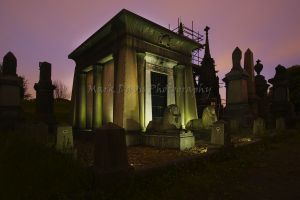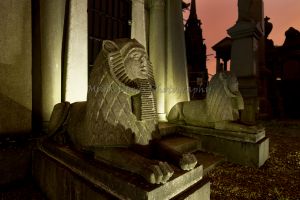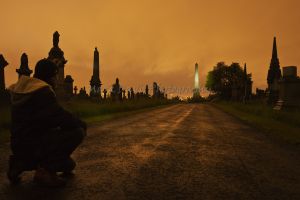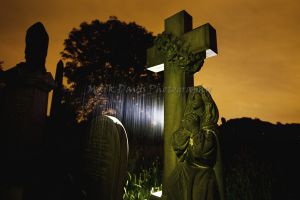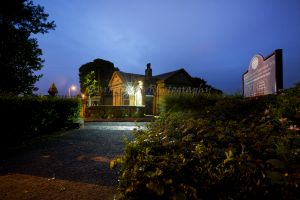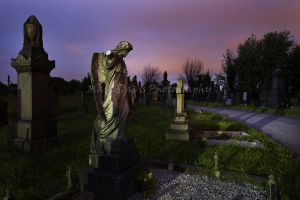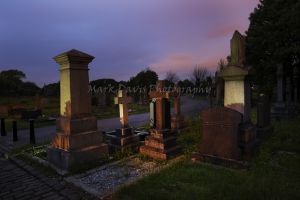June 7, 2017
Undercliffe Cemetery – A Brief History
In the 19th Century there was an enormous increase in the population of Bradford. The 1801 Census shows the population to be 13,264, most of whom lived on the north side of the beck. Fifty years later the population had risen to 103,778. This massive increase in population in such a short period of time caused immense problems of overcrowding and poor, insanitary conditions became much worse. Speculative builders added to the problems as there was little regard for planning. Houses were built without ventilation and owners often let cellars in order to increase their income. Water-supplies were often contaminated and refuse piled up in the streets to be collected infrequently.
Working conditions in the mills were equally horrendous. Children and adults worked extremely long hours for small wages at the mercy of the Overlookers. Factory accidents were common especially among children. The mortality rate in the 1840’s was especially high, in particular children and wool cambers. The average age for tradesmen and labourers was 17 years while that for professional men and their families was 30 years. In the insanitary, overcrowded areas epidemics were frequent. The cholera epidemic of 1849 resulted in 426 deaths and as most of these people were buried in the churchyard of St. Peter the graveyard became so overcrowded that bones were coming to the surface and causing a further health hazard. It was, therefore, necessary to set up new cemeteries on the outskirts of the town.
Before the passing of the Burial Acts in the mid 19th Century, burials had to take place according to the rites of the Church of England. This meant that the deceased were buried in the churchyard of the parish in which they died unless they had not been baptised, had been excommunicated or had committed suicide. The Burial Acts of 1852-1857 enabled Burial Boards to be set up either as separate bodies or as part of the Borough Councils. In Bradford a dual system of burial emerged: the newly created Borough Council opened and ran the cemetery at Scholemoor; while a group of businessmen formed a Joint Stock Company to run a private cemetery in Undercllffe.
The Bradford Cemetery Company was provisionally registered in 1849. By 185O the businessmen agreed that the best site for the new cemetery was in the Undercliffe area on the outskirts of the town. In 1851 one hundred acres of the Undercliffe Estate was put up for auction. Five days before the auction in July, thirteen well known non-conformist businessmen agreed to buy Lots 13 and 14, a total of 26 acres. Those signing the agreement included Henry Brown, Robert Milligan, Titus Salt, William Rand and Edward Ripley. John Horsfall bought the land for £3, 400, the cost being divided equally between the thirteen men. The site was on the crest of Undercliffe Hill overlooking the town and the townships of Eccleshlll, Idle and Shipley. Undercliffe Cemetery was to become a reality.
William Gay, registrar at Leicester Cemetery, accepted the post of Registrar at Undercllffe for £130 per annum with £10 removal expenses. The next year John Dale was appointed architect and Joseph Smith the Land Agent. The main feature of the elevated site was the great promenade running right through the cemetery with a terrace at the Western end giving panoramic views over the town and hills beyond. The total cost of the landscaping, building and planting was £12,000.
At a great ceremony in August 1854 the Bishop of Ripon consecrated the Western side of the cemetery for the burial of Anglicans. The smaller Eastern section was left for the interment of Nonconformists. Two mortuary chapels were built in 1854, but replaced 24 years later by larger ones designed by the prestigious firm of Lockwood and Mawson.
The first interment took place in March 1854. Unlike churchyards where rich and poor were buried side by side, the ability to pay governed the site of a grave in the new cemetery. Plots near the promenade and the centre were the most expensive. Charges ranged from £3 to £10. Many of the larger family graves occupied more than one plot. “Company” graves for those who could not afford a family plot were in the more remote areas of the site.
In 1855 an Order in Council closed many of the overcrowded burial grounds. One of those closed in Bradford was the old Quaker graveyard in Wakefield Road. The new Railway Company had acquired the site and so the Society of Friends purchased a small section in the newly opened cemetery at Undercllffe. They re-interred the disturbed remains of the Quakers in one large grave. Subsequent burials are marked with the simple and uniform flat gravestones.
Many of the wealthy, influential Bradford families bought plots in the Cemetery during the 19th Century. These include many Mayors, including the first, Robert Milligan. In the centre and along the main promenade the family monuments are impressive, providing memorials to men such as Behrens, Bolden, Illingworth, Mawson and Joseph Smith, the land agent.
During the middle of the 19th Century there was a growth in civic pride and new councils were keen to provide amenities for the people to enjoy. Undercliffe Cemetery was seen as one such improvement along with the new Parks and St. George’s Hall. The Directors of the Cemetery Company were also aware of this and the fact that many people used the site as a place of recreation as well as a burial ground meant that they set high standards for maintenance and expected visitors to behave properly when visiting the grounds.
During the first year 187 burials took place. From cemetery records it can be seen that the number of internments began to decline from 1900. By 1929 the number had dropped from a peak of 2466 in 1898 to 696 in 1928. Between 1854 and 1928, 105,742 Internments had taken place including bodies transferred from the Parish Church and the Quaker Cemetery. The decline in internments reflects the change in customs with more people opting for cremation. By the 1960’s the Cemetery Company was experiencing increasing financial difficulties. The losses of the Company were increasing and the number of internments in 1976 was just 72. The following year the Company went into liquidation.
In 1980 a property developer acquired the site. During the next few years there was growing concern over the condition of the site and the Friends of Undercliffe Cemetery was formed. After considerable pressure Bradford Metropolitan Council purchased the site in 1984, declared it a conservation area and sponsored a two year Community Programme to start the restoration. In 1985 a new Limited Liability Cemetery Company was formed, with council backing. The new Company achieved charitable status and has since become the Undercliffe Cemetery Charity. Slowly and steadily the number of visitors to the Cemetery has grown. The new Cemetery Charity and volunteers have undertaken work to educate the public about the importance of the Cemetery. They have produced guides and newsletters, held slide shows and open days, as well as providing facilities and guidance for schools and colleges. Once again the Cemetery is an asset to the town and continues in its original function as a worthy place of burial.
http://www.undercliffecemetery.co.uk/undercliffehistory.html
